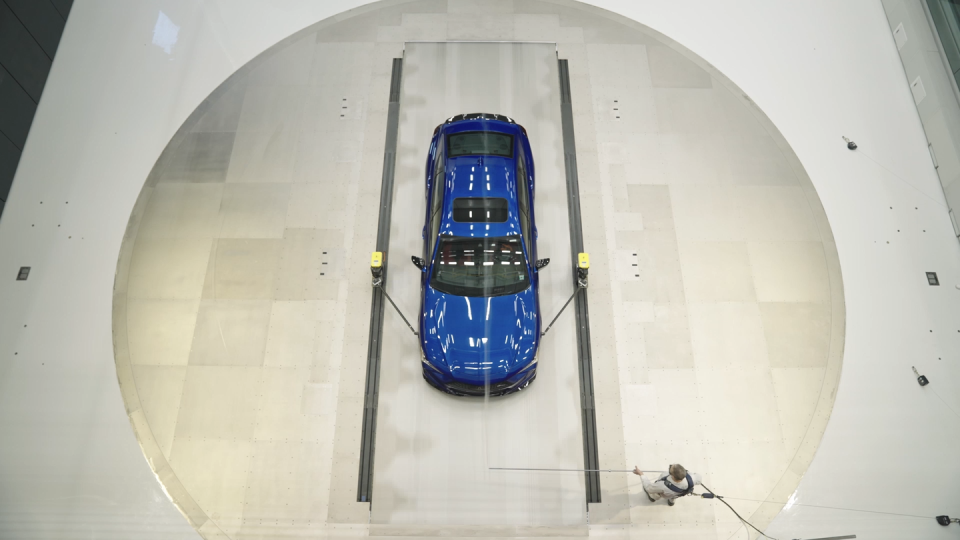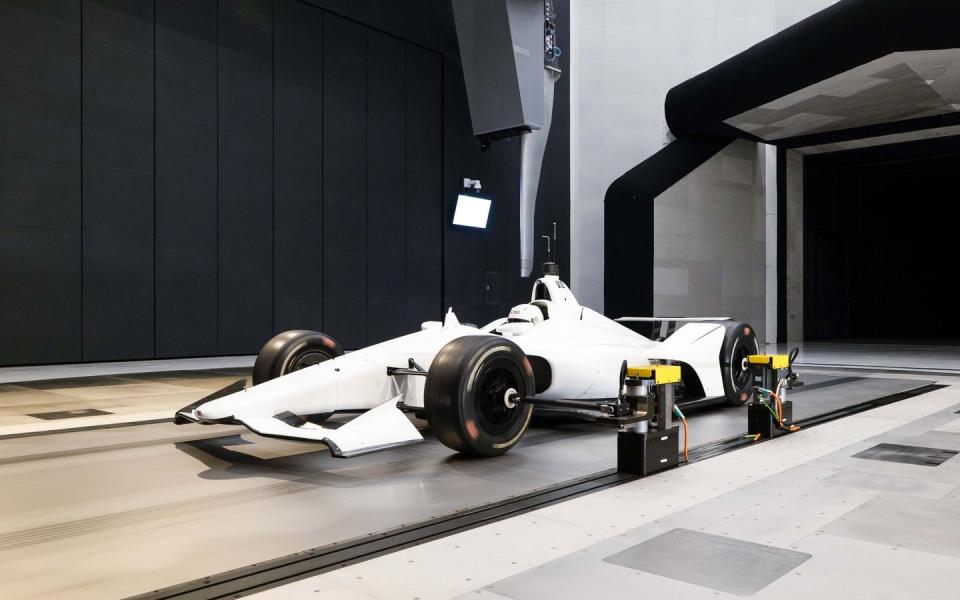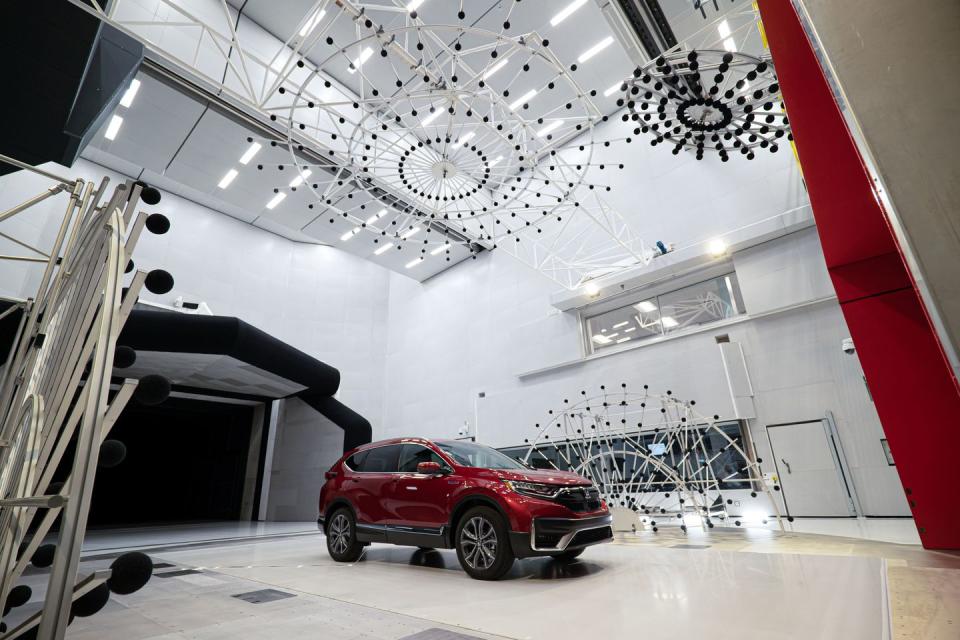This Badass Wind Tunnel Could Clear the Way for the Quietest Vehicles Yet

You might expect an automaker with Honda’s reputation to have all the latest tools for developing cars—including new battery electric vehicles (BEVs)—at its fingertips. But for years, the Tokyo-based automaker has actually been leasing wind tunnels from other car and aerospace companies and governments around the world to bolster its own facilities. That will change this fall when Honda finishes calibrating its $124 million state-of-the-art wind tunnel in East Liberty, Ohio, and begins aerodynamic testing.
The new Honda Automotive Laboratories of Ohio facility (HALO, for short) will do more than just help shape street cars and race cars to be aerodynamically slippery and fuel efficient; it will also allow Honda to fine-tune the sound of the air flowing over those vehicles. Wind noise is noticeable in any car, but in a battery electric vehicle, it’s a major distraction. A wind tunnel that can help designers minimize the noise could be a boon to the electric vehicle (EV) industry.
It’s reasonable to associate wind tunnels with aircraft, since aviation drove pioneering work in aerodynamics forward. However, wind tunnels have also been fixtures of the automotive industry since 1960, when the first purpose-built automotive wind tunnel—the Motor Industry Research Association tunnel—became operational at a former Royal Air Force airfield in Warwickshire, England. To provide airflow, it used four aircraft propellers as fans, each driven by a 325-hp electric motor.
In the decades that followed, automotive wind tunnels proliferated globally, including a trio of Honda tunnels in Japan. While Honda’s wind tunnels have served well, they haven’t been able to keep up with the company’s vehicle development demand, particularly in its biggest market, the United States.
“We had been renting [wind tunnel] facilities all around the world for the longest time,” Mike Unger, full-scale wind tunnel lead at Honda R&D Americas, tells Popular Mechanics. “It costs a lot of money to ship rather expensive prototype cars around the world.”
That strategy also puts such one-off prototype cars at risk, as evidenced by the sinking of the roll-on roll-off car carrier Felicity Ace back in March, when thousands of luxury vehicles—Porsches and Lamborghinis among them—went down with the ship after it caught fire in the Atlantic Ocean. Not to mention the other thorn in Honda’s side: the expense of having its engineers continually traveling (sometimes as much as two weeks a month) to leased wind tunnels across the map.
“It got to the point that our development load became high enough that [leasing] didn’t make sense anymore. We finally came to the conclusion that ‘Hey, we should build our own wind tunnel,’” Unger says.
The Sound of Drag

Discussions about a new tunnel began in 2015, when Honda envisioned a facility that could measure all the things that automotive engineers and designers care about most, from a vehicle’s overall coefficient of drag (a measure of the resistance of an object in a fluid environment such as air or water) to the way the air rushing over it sounds to the driver and passengers.
The automotive industry “only builds one of these kinds of tunnels every 10 years,” Unger explains, so getting the most out of it is vital. That includes integrating aeroacoustics—the ability to measure the sound around a car—for one very important reason.
“With BEVs there’s no more engine and no more exhaust, so wind noise becomes much more noticeable,” Unger says. (While BEVs are EVs, not all EVs are BEVs; battery electric vehicles store electricity provided from an outside source in a battery, while electric vehicles can receive electricity from onboard stored hydrogen, an internal combustion generator, or even solar panels.)
Minimizing wind noise for electric vehicles is a new facet of the noise vibration and harshness (NVH) factor that automakers have sought to tune and diminish for decades. It’s also something manufacturers can ultimately tout in their marketing. Honda’s new tunnel includes a system of acoustic arrays, made up of microphones and cameras, which are able to precisely measure sound in real time. The quietness of the tunnel itself even bolsters the sensitivity of the arrays.
“If you’re standing inside the [tunnel] test section, the wind noise at 87 mph is less than 57 [decibels],” Unger shares.
According to Yale University’s decibel level comparison chart, that’s comparable to the hum of a household refrigerator. Despite the wind generated by a huge 26-foot-diameter main fan, powered by a 6,700-hp (5-megawatt) electric motor, the quietude inside allows for more precise sonic measurement of cars or other objects placed therein. The power supply comes courtesy of Honda’s Transportation Research Center (TRC), which surrounds the new facility.
Aero for Everything, from Econoboxes to Halo Cars

“This tunnel is hard to beat in the world,” Unger says. Its aerodynamic and sonic-tuning capabilities apply to everything from Honda’s most modestly priced Civic LX to its $170,000 NSX supercar, the kind of flashy, high-performance ride commonly referred to as a “HALO car.”
HALO broke ground in 2017, and construction of the 110,000-square-foot facility wrapped up last year. The tunnel’s 10-by-16-by-49-foot open test section includes a 39-foot-diameter turntable that can rotate a car 180 degrees to the relative wind. (Most wind tunnels rotate only plus or minus 15 degrees.) Two nozzles are available for different velocities: an 82-square-foot nozzle, which can generate airflow up to 155 mph, and a smaller 59-square-foot nozzle capable of producing 192-mph flow.
The ability to puff air at nearly 200 mph means HALO will also be useful for developing and testing race cars. Honda has already had its wind tunnel correlation IndyCar in the facility. (Honda engines power about half the IndyCar teams.) Whether the HALO aerodynamicists need to measure cars at racing or highway speeds, they can rely on two 40-ton rolling road-belt modules (a single wide belt and a five-belt road) to pinpoint the aerodynamic interaction of fendered or open wheels with the surface.
Each road-belt module is essentially a giant treadmill driven by an electric motor. The treadmill sits on a calibrated balance with a three-axis load cell, allowing engineers to measure all forces on the test car sitting atop the rolling road. The belts ride on pulleys with complicated cooling, tracking, and vacuum systems to ensure they stay cool at speed, and they run straight and flat like a road. The “incredibly durable and specialized” belt material is smooth, Unger explains, providing just enough friction to turn a car’s wheels and tires.
Honda engineers can swap the modules beneath the turntable, a process that takes about four hours. The wide-belt road, which can rotate at up to 193 mph, is used for race cars and high-performance cars. Two struts, attached to the front wheel hubs, secure the car.
“Especially for open-wheel cars, spinning wheels are vital to get the right [aero forces] answer,” Unger explains. “If the wheels aren’t spinning, then you’re leaving out a large portion of the aerodynamic signature.”
Wheel rotation matters less for fendered cars or SUVs with higher ride heights. To assess the body aerodynamics of such vehicles, Honda uses the 155-mph-capable five-belt rolling road. (One belt is under each vehicle tire, and one larger belt is under the vehicle’s center.) The module has four posts, which clamp the car chassis pinch-weld line between the front and rear wheels.
Accuracy and Fresh Air

Accuracy is paramount for any wind tunnel, and Unger says HALO pushes the resolution of modern tunnels. It can record aerodynamic pressure down to 2.5 Newtons (about the weight of a standard D battery). And with energy-limited EVs, such precision matters even more.
“Aero becomes the driving factor in range,” Unger notes. “We’re striving to squeeze every bit of drag possible out of the design.” In general, a 10 percent reduction in a car’s aerodynamic drag equates to an increase of roughly 0.5 mpg. Such large drag reductions are made when a new model is designed or redesigned. HALO will be used to tweak drag later in the design phase wringing out 1-3 percent improvements. Combining small improvements with lower rolling resistance brakes, bearings and other components may allow a 2022 Accord to eke out an extra mile or so in range.
But what works in the wind tunnel or digital world may not always work in the real world. So Honda has three “correlation cars”—cars tested on the road and in other wind tunnels—with known aerodynamic signatures that it can use to confirm the data HALO generates.
The sensitivity and capacity of HALO is impressive, but to the engineers who will work there, so are its conveniences. Wide access allows for loading cars in and out quickly. Movable arrays make changing from acoustic to aero mode a half-hour breeze. Its multiuse quality means engineers of different disciplines from different countries can work side by side, learning from as well as with one another. The adjacent control room also has a break room and an outdoor patio which Honda’s wind tunnel lead says is anything but superfluous.
“You can go get fresh air and actually see the sunshine rather than staying in a cave for 12 hours at a time. I’ve done enough testing over the years that I can remember going to work when it was dark and leaving when it was dark. Do that for a month at a time, and things become pretty dark in your world.”
The tunnel’s newness means it has yet to acquire a nickname or fully reveal its windy character to those who’ll work day after day within. But Mike Unger assures me that sooner or later, HALO will show itself.
“As you work with a machine for as long as we do, it will have a personality. When a certain noise changes, people who have been there for a long time instantly know something’s up. It can be a tonal change or a small vibration and we know. We’re still working through what HALO’s personality will be.”
You Might Also Like

